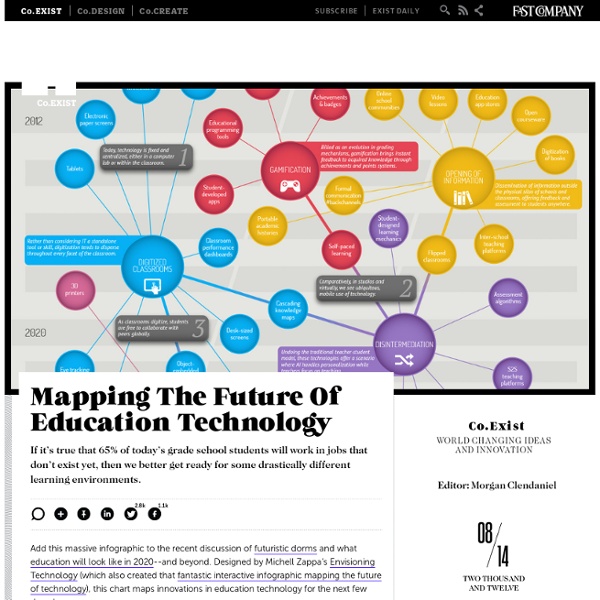10 Great Tips to Create Beautiful Slideshow Presentations
The focus now has been shifted from just enabling teachers and students to use digital tools to create presentations to focusing on the quality of these presentations. Are they well structured ? Do they communicate clear messages ? Are they engaging and thought provoking ? and the list of questions goes on and on. Educational Technology and Mobile Learning realizes the importance of presentations as teaching and learning tools and has featured several posts in this regard such as : 1- A List of 20 Tools for Teachers to Create Presentations and Slideshows 2- 10 Excellent Alternatives to Power Points 3- Free Templates for your Presentations 4- The Best Slides and Presentations Search Engines for Educators 5- 4 Great Power Point and Slideshow Resources for Teachers to Download Today we are sharing with you a great slideshow we learned from Dawson College.
Mapping parties
Mappers learning to use GPS receivers Mappers entering data into JOSM OpenStreetMap is only as good as the contributions of the people who edit it. To encourage and help people to edit, OpenStreetMap enthusiasts can run Mapping Parties. It is a convivial community event, open to all, and although some folks will be mapping experts, newcomers are always welcome. The schedule of a mapping party can take several forms, for example a simple mapping party can just involve going to a nominated pub after doing some mapping, but typically a larger event will involve meeting beforehand to discuss the plan and to team people up. For effective training of beginners it's a good idea to have at least one laptop, to demonstrate editing. After the mapping is finished, the participants share food and drinks, and enjoy themselves. See Current events for a list of mapping parties happening in the coming months. See also:
Alcohol & Drug Awareness Activities (K-12
Easter & Passover Get ready for fun classroom crafts: Easter and Passover are both approaching! Passover begins Friday, April 14 and Easter is Sunday, April 20. Poptropica Teaching GuidesPoptropica is one of the Internet's most popular sites for kids—and now it's available as an app for the iPad! April Calendar of Events April is full of holidays and events that you can incorporate into your standard curriculum. Common Core Lessons & Resources Is your school district adopting the Common Core? Videos Do your students love videos?
Your Quick Guide to Teaching with iPads
Below is an awesome infographic shedding more light on the use of iPad in education.It provides some amazing facts about the potential of this mobile device in learning and reviews the reasons behind this growing popularity of iPad in the educational circles. I find this infographic to be a nice addition toTeachers Guide on The Use of iPad in Education.Give it some time and read through it attentively and share it with your colleagues. All thanks go to Online Universities for creating this infographic.
OpenStreetMap, apoyando lo bonito.
Llevo rato interesado en todo esto de OpenStreetMap y hoy fue que me puse a investigar mas a fondo, directamente desde el celular y a ver que iba todo esto. Ya se sabe que es una plataforma cartográfica en la que cualquiera puede editar los mapas y las bases de datos de los mismos para poder crear un mapa en linea gigantesco lleno de información, esto por encima, claro está. Es interesante todo este proyecto porque permite directamente personalizar tus mapas, no en el sentido de que “Oh, tengo un mapa propio” sino en el sentido de que podemos puntear y editar mapas para enriquecer la información que en ellos existe. Ahora bien, esto lo discutí con una amiga fanática empedernida de los Google Services y de Apple (que contraproducente ¿no?) Anda, vale, todos somos libres de escoger lo que se nos venga en gana y yo elijo OSM por mis propias razones, pero ella hizo una pregunta que responden perfectamente en la Wiki del proyecto (en español, por cierto) la pregunta fue ¿Por qué OSM?
Learning and Teaching - Drug Education
The aim of this section is to assist schools, student welfare coordinators and teachers to implement ongoing improvement in drug education for their students. This section contains drug education resources for schools and teachers to assist with drug related issues involving truancy and student retention. These resources can be used within all four domains of the Physical, Personal and Social Learning strand of the Victorian Essential Learning Standards Please note where the former Victorian Government Schools Reference Guide is noted in documents please refer to the School Policy and Advisory Guide Drug Education in Victorian Schools – Get Ready Years 7-9 curriculum resources The Get Ready evidence-based drug and alcohol education program for Years 7-9 has been successfully trialled in 21 schools, involving 1750 students. The program received the Excellence in Prevention and Community Education Award, one of nine National Drug and Alcohol Excellence awards in 2012. The materials are:
Q-and-A: Educators should move beyond "tradition-bound" education SmartBlogs
Educators returning to the classroom this fall are facing many new challenges, including implementation of the Common Core State Standards. There also is a growing demand and higher expectation for educators to connect digitally with students and to differentiate learning for students’ individual needs. “Everyone returning to school should understand these challenges and prepare to face them in a very robust and bold way,” says Gene R. Carter in this interview with SmartBrief’s senior education editor Melissa Greenwood discusses the impact of the Common Core State Standards on schools, how technology is changing the classroom, and highlights one issue that he thinks will be a game changer for America’s schools. Forty-five states have adopted the Common Core State Standards for both mathematics and English language arts. There are common core critics, some of them teachers. The standards will require change on the part of educators, and that can be difficult.
Enfoque Pedagogico: Constructivismo



